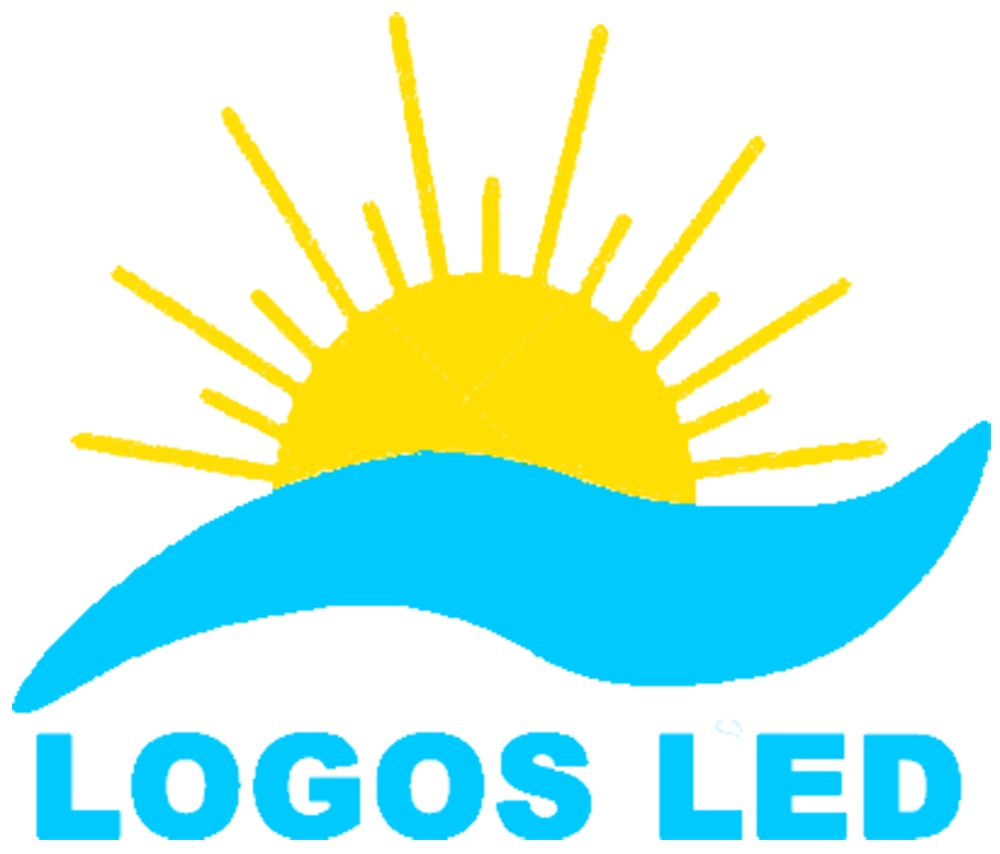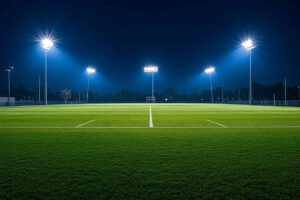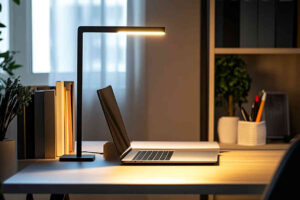If your tennis courts don’t have good lighting, you won’t be able to see well enough to play well. It’s also dangerous because you can’t see well enough to not trip and fall. Plus, people will be less likely to play on your tennis courts if they’re not lit well. So, if you want to have safe, fun, professional-level tennis courts, you need good, quality, outdoor tennis court lighting.
When choosing outdoor tennis court lights, make sure they are bright enough for the level of play (200-300 lux for recreational, 500-1500 lux for competitive), spread out nicely across the court (0.6 uniformity ratio or better), have no glare (anti-glare fixtures), are energy efficient and durable (LED), have a color temperature of around 5000K to 5700K, have a high CRI, and are mounted 6-12 meters high. Do these things, and your players will see better, play better, and you’ll spend less on maintenance and your power bill.
Don’t stop here! Keep reading to get the nitty-gritty details on how to make the right lighting choices for your tennis court.
Table of Contents
Key Factors to Consider When Choosing Tennis Court Lighting
When it comes to lighting your tennis court, you want to make sure that your players can see the ball, play their best, and have a great experience. There are a few things to consider when it comes to your tennis court lighting: How bright is it? How efficient is it?
1. Lux Levels and Brightness
The first and most important factor is the brightness of the lights, which is measured in lux. The lighting must be bright enough for players to clearly see the ball and judge their movements.
- For recreational play, aim for 200–300 lux.
- For competitive or professional play, a range of 500–1500 lux is required.
Ensure that the brightness is consistent across the entire court to avoid any dark spots or areas with excessive light.
2. Uniformity of Light Distribution
Uniform lighting is a big deal. You don’t want any shadows or areas that are too bright where a player can’t see. The uniformity ratio (minimum lux ÷ average lux) should be at least 0.6–0.7 for standard courts. This helps to make sure that you have a consistent playing environment and reduces any issues with the lighting being a distraction.
3. Glare Reduction
Glare is a big deal for outdoor tennis courts, especially when players are looking into the light. Fixtures need to be properly designed with anti-glare technology or have the beams angled correctly to make sure the glare doesn’t blind the players. This is a big deal because you want the players to be able to see, and you want them to be comfortable.
4. Color Temperature and Color Rendering
The color temperature of the lighting affects the overall lighting effect. A range of 5000K to 5700K gives you a daylight effect and helps players see the ball. The Color Rendering Index (CRI) of the lights should be 70 or higher to make sure the colors are accurate. If you’re doing professional courts, you want a CRI above 80, especially if you do any broadcast events.
5. Energy Efficiency
Energy efficiency is a big deal because it reduces your operating costs. The best type of lights for tennis courts are LED lights because they are highly energy efficient, last a long time, and require very little maintenance. You can save 50–70% on your energy costs compared to traditional lights with LEDs. Make sure to look for certifications like CE, RoHS, or UL.
6. Durability and Weather Resistance
Outdoor lighting needs to be able to handle the weather. Be sure the fixtures have a high IP rating (at least IP65) to protect them from dust, water, and temperature extremes. This is especially important if you’re in an area with unpredictable weather.
7. Pole Height and Fixture Placement
How high should the light poles be? Most of the time, the poles will be between 20 and 40 feet tall, depending on the size of the court and the level of play. How you position the lights is critical. You want to make sure the light is even across the entire court.
8. Maintenance and Lifespan
LED lights last a lot longer (up to 50,000 hours) than traditional lights, which means you will spend less money on replacement lights. Pick out good-quality, tough light fixtures that are easy to maintain, and you’ll save a lot of time and money.
By considering these things, you can make sure the lights work right, save money on your electric bill, and have lights that make the tennis players happy.
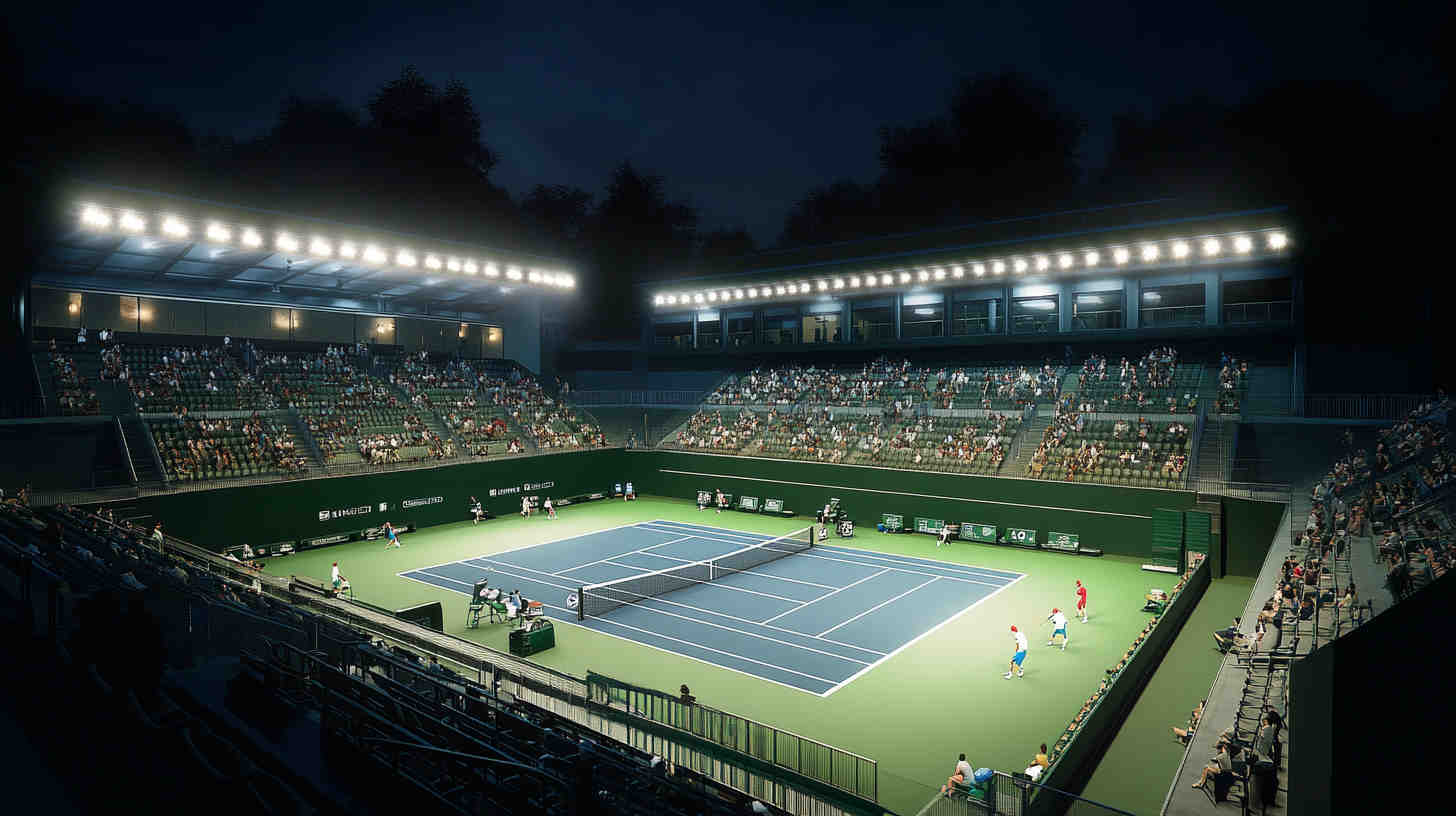
Requirements and Standards for LED Tennis Court Lighting
By understanding these things, you can make sure the lights work right, save money on your electric bill, and have lights that make the tennis players happy.
1. Lux Levels for Adequate Illumination
Lighting is important for tennis courts to ensure a safe and fun playing experience. LED lighting is the way to go because it’s energy efficient, lasts a long time, and performs the best. Here are the important things to consider for lighting your tennis court:
1. Class I: National and International (1,350 Lux)
This is the highest level of lighting required, designed for international and professional competitions. It ensures the court is bright enough for televised broadcasts and large audiences.
- Lux Required:1,350 lux
- Use: Professional and international matches with a large number of spectators, including high-profile tournaments like Grand Slam events.
- Lighting Characteristics: High brightness with uniform light distribution across the court. Facilities in this category must also be capable of handling broadcasting needs, requiring optimal clarity for both players and viewers.
2. Class II: Club Competition and Commercial (800-1,000 Lux)
Class II lighting is suited for club-level competitions and high-level training. This category includes collegiate or commercial tennis facilities, and the lighting is designed to meet the needs of both players and spectators at mid-level events.
- Lux Required:800-1,000 lux
- Use: Club-level competition, training, and recreational play at a high level. Some collegiate or community facilities may also fall into this category.
- Lighting Characteristics: Bright enough for competitive play, but not as intense as Class I. It provides a balance of visibility and cost-efficiency, making it ideal for facilities with moderate spectator attendance.
3. Class III: Residential and Recreational (500-750 Lux)
Class III lighting is intended for local, recreational, or school-level play. These courts may be used for casual matches or training but do not typically host large-scale events or broadcasts.
- Lux Required:500-750 lux
- Use: Local competitions, general training, recreational play, or school team activities.
- Lighting Characteristics: Lower brightness than the higher classes, but sufficient for a safe playing environment. This class is typically used in community or recreational tennis courts where there is less emphasis on broadcasting or large audience needs.
4. Class IV: Recreational (200-500 Lux)
Class IV represents the lowest level of tennis court lighting, designed for purely recreational play with no emphasis on competitive performance. These courts are often located in public parks or residential areas.
- Lux Required:200-500 lux
- Use: Strictly for recreational play in public parks, residential areas, or facilities with limited use.
- Lighting Characteristics: Provides the minimum illumination needed for recreational players to enjoy the game at night, without the need for high-intensity lighting.
Below is a table for the lighting requirements of each class:
| Class | Lux Required | Use | Lighting Characteristics |
| Class I | 1,350 lux | Professional and international matches with large audiences, including high-profile tournaments like Grand Slam events. | High brightness with uniform light distribution. Designed to handle broadcasting needs, ensuring optimal clarity for players and viewers. |
| Class II | 800-1,000 lux | Club-level competition, high-level training, collegiate or commercial facilities. | Bright enough for competitive play but less intense than Class I. Balanced visibility and cost-efficiency for moderate spectator attendance. |
| Class III | 500-750 lux | Local competitions, general training, recreational play, or school team activities. | Lower brightness, sufficient for safe play. Used in community or recreational courts with less emphasis on broadcasting or large audiences. |
| Class IV | 200-500 lux | Strictly recreational play in public parks, residential areas, or facilities with limited use. | Minimal brightness for casual play. Designed for recreational facilities with no emphasis on competitive performance. |
2. Uniformity Ratio
- The uniformity ratio (minimum lux ÷ average lux) must be maintained between 6 and 0.7. This prevents shadowy or overly bright areas, which can distract players and reduce visibility.
3. Glare Control
- Glare should be minimized to avoid distractions. Fixtures with anti-glare designs, precise beam angles, and diffusers help achieve this. Standards like the Unified Glare Rating (UGR) should be considered, with a target UGR of less than 22 for tennis courts.
4. Color Temperature and Rendering
- Color Temperature: A range of 5000K to 5700K is ideal, as it provides a natural daylight feel.
- Color Rendering Index (CRI): A CRI of 70 or above is required for recreational use, while professional courts may need CRI levels of 80 or higher for better color accuracy during televised events.
5. Pole Height and Light Placement
- Poles are usually installed 6-12 meters high for the best coverage. You don’t want lights directly above the court shining in your eyes. You mount the fixtures outside the court somewhere and angle them down to light up the court.
6. Compliance with Standards
- International Tennis Federation (ITF): Recommends specific lux levels and uniformity for different court uses.
- EN 12193 Standard: Commonly followed in Europe, detailing lighting requirements for sports facilities.
- Broadcasting Requirements: For televised matches, standards like HD and 4K broadcasting call for higher lux levels, uniformity, and CRI.
Meeting these requirements ensures tennis courts are well-lit, professional-grade, and suitable for diverse playing conditions.
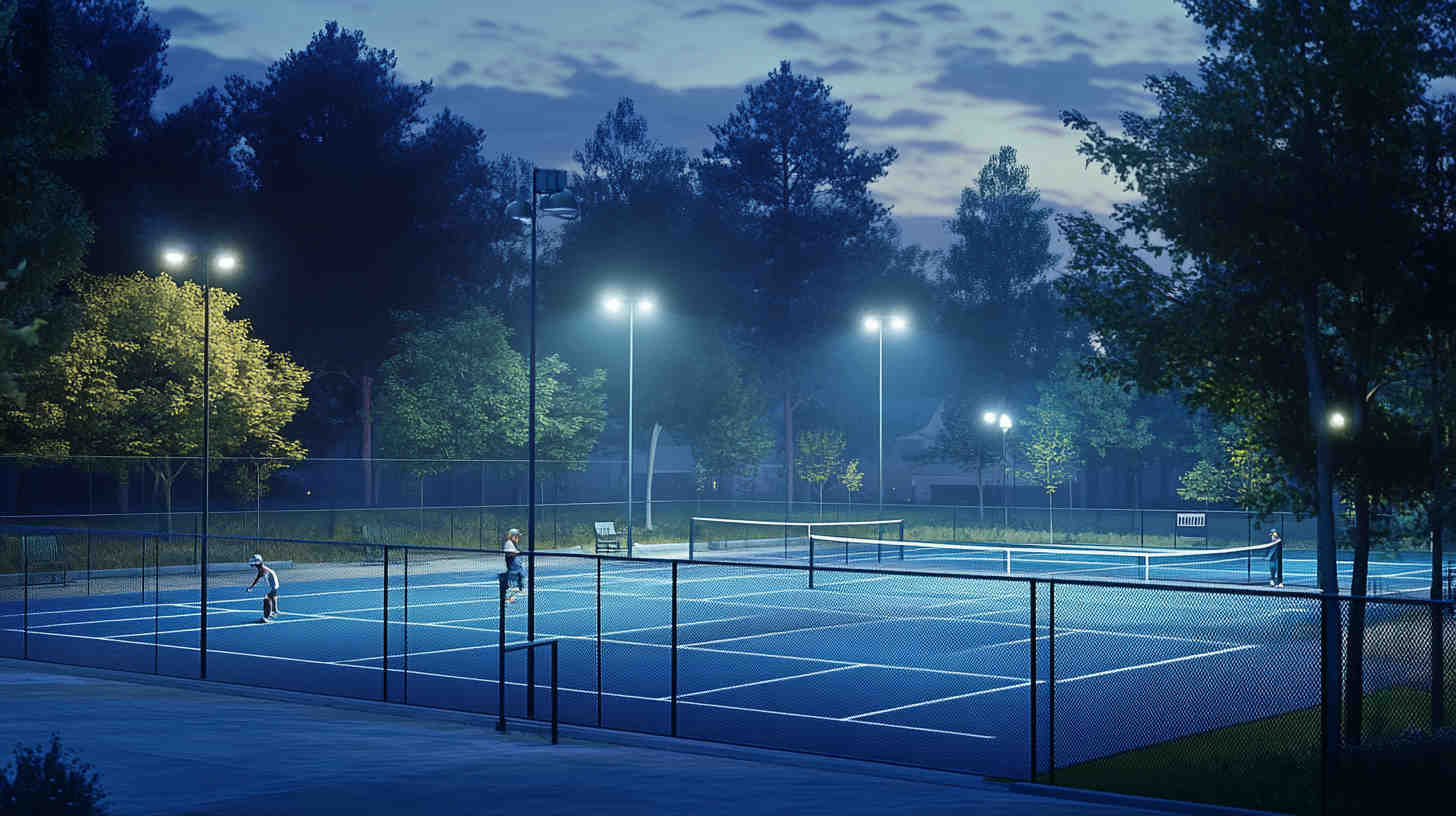
Lighting Design Considerations for Tennis Court Lighting
When designing lighting for tennis courts, there are several things you need to think through to get the best performance, make sure the players are comfortable, and save money in the long run. You need to think about the size of the court, where to put the lights, and how to save energy.
1. Court Size and Layout
The size and layout of the tennis court significantly influence the lighting design.
- Standard Court Dimensions: A full-size tennis court measures 77m x 10.97m (78ft x 36ft) for doubles and 23.77m x 8.23m (78ft x 27ft) for singles.
- Lighting Zones: Ensure even light distribution across the playing area and beyond the court boundaries. Lights should adequately cover run-off areas to prevent shadows and ensure player safety.
- Pole Placement: For a standard court, four to eight light poles are typically used, depending on the light output and fixture design. These are positioned symmetrically along the sidelines.
Proper lighting placement ensures minimal glare and uniform coverage, which are critical for competitive and recreational play.
2. Height of Lights for a Tennis Court
The height at which lights are installed directly affects visibility and glare control.
- Optimal Pole Heights: Poles should typically be 6m to 12m (20ft to 40ft) tall, depending on the court type and the level of play. Higher poles are better for reducing glare and achieving broader light coverage.
- Fixture Mounting Angle: Lights should be angled to direct beams downward without shining into players’ eyes.
- Avoiding Shadows: Use precise beam angles and well-designed optics to eliminate shadows, especially near the net and baseline areas.
A thoughtful combination of height and angle ensures the court is evenly lit while minimizing light pollution.
3. Energy Efficiency and Cost Savings
Energy efficiency is one of the top priorities for tennis court lighting to reduce operational costs and environmental impact.
- LED Technology: LED lights consume up to 50–70% less energy compared to traditional lighting systems. Their long lifespan minimizes replacement costs, often exceeding 50,000 hours of usage.
- Dimmable Fixtures: Install lights with dimming options to adjust brightness during off-peak hours or for recreational use.
- Motion Sensors and Timers: Automating lighting systems can save energy by ensuring lights are only on when needed.
- Energy Audits: Regular audits can help identify inefficiencies and optimize the system for maximum savings.
By focusing on these design considerations, tennis court lighting can deliver high-quality performance while being cost-effective and environmentally sustainable.

How to Select the Best Lighting for Your Tennis Court
When you’re designing the lighting for tennis courts, there are a few things you need to think through to get the best performance, make sure the players are comfortable, and save money in the long run. You need to think about how big the court is, where to put the lights, and how to save energy.
1. Prioritize Brightness and Uniformity
- Brightness Levels: Select LED lights with appropriate lux levels. For recreational use, a minimum of 200–300 lux is sufficient, while competitive or professional courts require 500–1500 lux, depending on the level of play.
- Uniform Illumination: Look for lights designed to distribute light evenly across the court. A uniformity ratio of at least 6 ensures there are no shadows or uneven lighting zones.
2. Opt for Energy-Efficient LED Lighting
- LEDs are the most energy-efficient option, consuming significantly less power than traditional metal halide or halogen lights.
- Choose fixtures with high lumens-per-watt ratings to maximize brightness while minimizing energy consumption.
- Look for features like dimming controls or motion sensors to reduce energy usage during non-peak hours.
3. Minimize Glare for Enhanced Comfort
- Glare can distract players and reduce visibility. Select fixtures with anti-glare technology or well-designed optics that direct light downward and minimize spill light.
- Ensure lights are mounted at proper angles and heights (6m–12m) to further control glare and light pollution.
4. Consider Color Temperature and Rendering
- Choose a color temperature between 5000K and 5700K for a natural, daylight-like appearance. This range enhances visibility and reduces eye strain.
- Ensure the lights have a CRI (Color Rendering Index) of 70 or higher, or 80+ for professional courts, to ensure accurate color visibility, which is crucial for televised matches.
5. Evaluate Durability and Weather Resistance
- Outdoor tennis courts require fixtures that can withstand various weather conditions. Look for lights with an IP65 rating or higher to ensure protection against water, dust, and extreme temperatures.
6. Match the Lighting Design to the Court’s Layout
- Ensure the lighting design is tailored to the court’s size and layout. A standard tennis court typically requires four to eight light poles strategically placed to illuminate the court evenly without shadows.
- Confirm that the lighting setup complies with guidelines from the International Tennis Federation (ITF) or other relevant standards.
7. Focus on Long-Term Cost Savings
- Invest in high-quality LED fixtures with a long lifespan (50,000+ hours) to reduce replacement and maintenance costs.
- Use lights with certifications such as CE, RoHS, or UL to ensure efficiency and safety compliance.
By considering these factors, you can select tennis court lighting that enhances gameplay, ensures player comfort, and minimizes operational costs over time.
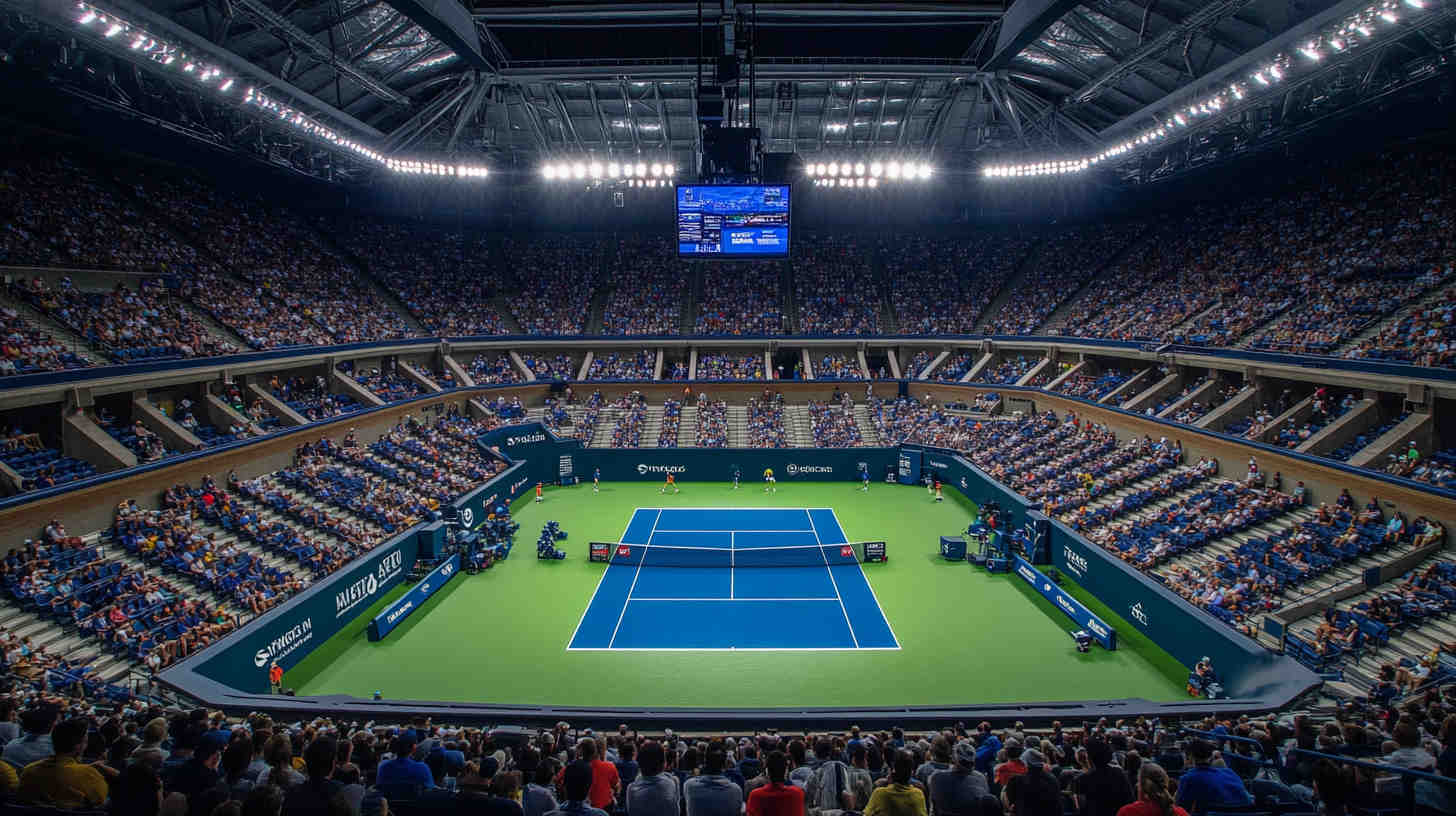
FAQs about Tennis Court Lighting
What Are the Lighting Guidelines for Tennis Courts?
Here are some general lighting rules of thumb for tennis courts. Professional matches require a lot of light and uniformity. Recreational courts can get by with a little less. According to the International Tennis Federation (ITF), you need to have lights that are bright enough and uniform enough to see the ball and not have any shadows. You need to think about where to put the poles, how to angle the lights, and what kind of lights to use.
How Many Watts to Light a Tennis Court?
Well, that depends on the size of the tennis court and the type of LED lights you use. A general rule of thumb is that a standard outdoor tennis court needs about 12,000 to 20,000 watts if you use traditional lights. With LED fixtures, you can get away with about 4,000 to 8,000 watts to get the same light.
What Is the Best Color for a Tennis Court?
Most people like to light their tennis courts dark green or blue because these colors provide great contrast with the white tennis ball. When you have the right lights on your court, your dark green or dark blue court will pop at night.
How Much Light Do You Need for a Tennis Court?
How many lights do you need? A standard tennis court needs between 200-750 lux, depending on what you’re doing on the court. If you’re playing recreationally, you need around 200-300 lux. If you’re playing professionally, you need about 500-1500 lux to meet competition standards.
What Is the Lux Level for a Tennis Court Light?
Lux refers to the amount of light per square meter. For tennis courts, we need to have the right number of lights to ensure the right amount of light across the playing surface. For regular tennis courts, you need 200-300 lux. For professional tennis courts, you need 500 lux or more.
How Many Lumens Do You Need for a Sports Court?
The total lumens you need depend on how big your court is and how many lux you want. For a 23.77m x 10.97m outdoor tennis court, you need roughly 130,000 lumens to get 500 lux. You can get there with fewer LED lights.
How Bright Are Tennis Court Lights?
Tennis court lights range from 200 to over 750 lux. The brighter the lights, the easier it is for players to see the ball and react to it during a match.
What Is the Light Angle for a Tennis Court?
The best angle for the lights is to point them down at an angle. This way the light is not shining in your eyes and you still get good coverage on the court. Most people use a 30°–60° floodlight to light the court.
How to Light Up a Tennis Court?
To light a tennis court, you install really good LED floodlights on poles around the court. Put the poles up around the court, evenly spaced. Put them up 8-10 meters high. They’ll light the whole court. Get LED lights that have anti-glare optics, so they’re not glaring back at you.
How Much Does It Cost to Light a Tennis Court?
The cost to light a tennis court depends on the type of fixture and the complexity of installation. On average, you should expect to pay around $10,000 to $25,000 US dollars per court for a good LED system. That includes the fixtures, the poles, and the installation. While the upfront cost for LED lighting is higher, you save a ton of money on your energy bill and maintenance over the long run.
How Many Watts Are Tennis Court Lights?
Modern LED tennis court lights usually run between 400 and 1,500 watts per fixture, depending on the design and the lumens you want. They are super-efficient, and that’s why they’re a cost-effective choice compared to old-school lights.
How Do You Layout a Tennis Court?
To get the light right on a tennis court, you need to put the poles in symmetrical places to get even coverage. The most common way to do this is with four or six poles 8 to 15 meters high around the court. You put LED floodlights with the right beam angles on top of the poles.
What Temperature Should The Lights Be on a Tennis Court?
LED lights that have a color temperature between 4,000K and 6,500K are perfect for tennis courts. This range of LED lights will give you daylight-quality light. This makes it easier for players to see and will help reduce eye strain if you’re playing under the lights at night.
Conclusion
Now you know the right outdoor tennis court lighting to make your tennis courts safe, visible, and fun for players. Follow the lighting standards, choose LED systems to save money, and talk to professionals to make sure you get the right lights in the right places. We can help you with our customizable LED lighting solutions at Logos Lighting. Contact us today and we’ll get your tennis court lit up right!
